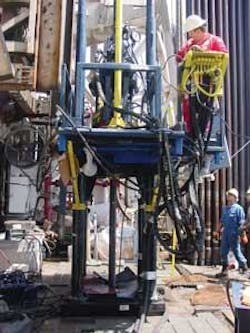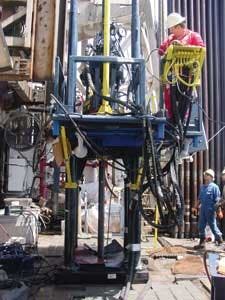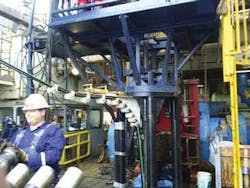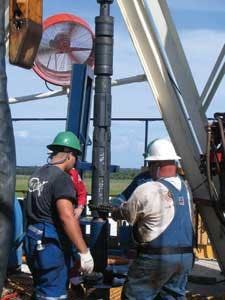New technologies aid in exploration, production success
Monty Montgomery, Errol Sonnier, Dan Wiggins - Tesco Corp.
As the offshore oil and gas industry continues to explore for new reserves in deeper waters and drill and complete new horizons in mature and depleted fields, various technologies continue to be introduced to aid in their success. In some cases, two unique technologies are combined to increase the success rate. In other situations, continually evolving technology aids in installing complex completions in new deepwater wells.
One technology used to drill new reserves from brownfields as well as new exploration combines Tesco’s Casing Drilling technology with a rotary steerable system (RSS) or positive displacement motor (PDM). This combination of technologies has been proven in the North Sea and offshore Qatar. The company has alliances with Halliburton and Schlumberger to provide directional Casing Drilling services with rotary steerable systems.
When developing reserves, the company’s Multiple Control Line Running System (MCLRS) can eliminate damage and the need to splice control and injection lines. The MCLRS is now in its third generation.
Casing drilling
The Casing Drilling process uses standard oilfield casing to drill the well and then leaves it in place to case the well. This process makes it possible to increase the rate of drilling by 20-30% or more by eliminating drillstring tripping and associated problems. Drill bits and other downhole tools are lowered and retrieved via wireline inside the casing and latched to the bottom-most joint.
Casing while drilling also allows an operator to drill through hazard zones with improved borehole quality and reduced reservoir damage.
Virtually any rig with a top drive can use Casing Drilling because no rig modification is required. It provides the ability to rotate the casing and circulate at the same time while tripping or running pipe into the well, improving well control.
The plastering effect resulting from casing while drilling can enhance reservoir productivity by reducing or eliminating fluid losses to the producing horizon as well as to mitigate mud invasion through permeability. The plastering effect results from the smooth, continuous contact of the casing as it rotates against the wellbore wall, packing the drilled solids into the porous and permeable portions of the formation as drilling fluid carries the cuttings up the annulus.
Directional casing while drilling
Directional casing while drilling (DCWD) combines the company’s Casing Drilling services with rotary steerable systems.
The first use of DCWD with a rotary steerable system offshore was in the Norwegian North Sea for ConocoPhillips on the Eldfisk Bravo platform. The 10 ¾-in. (27.3-cm) and 7 ¾-in. (19.7-cm) intervals of the well were drilled successfully with DCWD using a Schlumberger PowerDrive X5 RSS, PowerPak straight positive displacement motors, and Pulse telemetry and surveying systems. The 10 ¾-in. section was drilled to 21° inclination to 4,887 ft (1,490 m) MD. The 7 ¾-in. interval was drilled to 60° inclination while making an 87° turn to 12,088 ft (3,684 m) MD. Losses were minimized in both intervals, there were no stuck pipe problems, and the BHA was retrieved with a wireline traction winch.
The 10 ¾-in. section was drilled in one bit run from 1,120 ft (341 m) to 4,887 ft (1,490 m) MD. Directional control achieved the dogleg severity (DLS) as planned at 2.53°/100 ft (30.5 m). The interval built to 21° and included a 100° left turn. The plastering effect resulted in a full gauge hole with minimal losses. Rate of penetration (ROP) held to 50 ft (15 m)/hr on bottom, with the final three casing joints drilled at 80-90 ft (24-27 m)/hr.
The 7 ¾-in. section was drilled from 4,887-12,088 ft (1,490-3,684 m) MD. Build rates of up to 4.83°/100 ft (30.5 m) were achieved. Rate of penetration (ROP) of up to 100 ft (30.5 m)/hr was achieved, and the casing RPM was fast enough at 30 rpm to generate the plastering effect. Casing wear in both intervals was below model predictions.
Minimal lateral vibration and shock loads were experienced. In fact, less vibration was evident than is typically experienced with RSS on conventional drillpipe. Additionally, casing whirl was virtually non-existent and no slip/stick or bit whirl was experienced.
Overall, DCWD on this particular well resulted in less pipe handling; lower stress on older drilling equipment; no time spent on attempting to cure lost circulation; both sections were drilled with lower weight mud; lower gas levels were encountered; on-bottom ROP was equal to conventional drilling; targeted hole conditions were achieved; and directional objectives were met.
In another well, Tesco and Occidental Petroleum drilled the first directional Casing Drilling well in the Middle East offshore Qatar using Schlumberger’s PowerDrive RSS from theHercules 16 jackup rig. Tesco’s Casing Drilling technology in tandem with the Schlumberger alliance agreement was used to drill a complex directional 12 ¼-in. (31-cm) hole with 9 5/8-in. (24.4-cm) casing through the Nah Umr formations. Two BHAs were used to drill the 2,025-ft (617-m) section. The BHAs were retrieved and set using drill pipe. No reaming or backreaming or circulation was required as the well built from 28° to 75° and turned 26° with a maximum dogleg severity of 5°/100 ft (30.5 m).
No rig modification was required to drill the well and no Health, Safety, and Environmental (HSE) incident occurred during the job. Actual torque and drag was comparable to drilling with conventional drill pipe, and Tesco’s casing drilling engineer’s torque modeling proved reliable. No lost circulation or stuck pipe incidents occurred and the hole was stable throughout the entire drilling of the section, resulting in a gauged hole with no downtime or tool failure.
Control line running system reduces NPT, improves safety
When running completions, damage to control lines usually results from human error, such as unintentionally closing the slips. The control line clamp being lowered and drawing the slip body into the control lines is one of the reason for control line damage. Another reason is using the wrong control lever. Tesco’s patented Multiple Control Line Running System (MCLRS) handles control lines without running them through the slips, eliminating the possibility of damage that can result in downtime. The company has run completions with as many as 10 control lines without damaging the lines.
The MCLRS is a raised platform installed over the rotary that elevates the slips 6 ft (1.8 m) and in some cases 7 ft (2.1 m) above the rig floor, providing unrestricted access to the tubing string below the slips. Control lines are fed through the open platform sides of the MCLRS without having to pass through the slips and are then clamped to the tubing string below the elevated slips. In addition to installing completions, the MCLRS can also be used for pulling completions in preparation for well interventions or to repair or install a new completion.
The tubing makeup and clamping stations are separated into two physically segregated areas for improved safety and more efficient operations. In the basket area above the rotary, the tong crew adds joints of tubing to the string, where it is held in slips mounted above the clamping workstation. At the clamping station below the basket area, each control line is fed through a hydraulically positioned guide to align the control line with the tubing string. The clamping crew places clamps, or Control Line Protectors, around the tubing and control lines, bolting them together to hold the lines firmly in place against the string.
The result is safer and faster operations because no control lines are in the tong area, sheaves are not rigged up overhead, and control lines never pass through the slips. The crew operates the tongs in the basket above the MCLRS window, or false rotary, with all tong and pipe stabbing operations performed in the basket. Additionally, the tongs and control line guides can be operated completely remotely, further increasing efficiency and safety.
Another tool that can be used with the MCLRS is the company’s patented MarkFree handling system for installing chrome tubulars without slip or elevator marks. The company has run numerous completions using MarkFree for operators using high chrome content tubulars, for example, or for handling tubulars that the operator intends to remain in place for many years. Use of the MarkFree system ensures the chrome tubing is as it was purchased, reducing the risk of corrosion issues.
MCLRS technology was first used in the Gulf of Mexico to install subsea completions for BP’s Nile project. This project also involved the first deepwater completion from theDiscoverer Enterprise, a Transocean Inc. deepwater drillship. To date, the company has run more than 100 deepwater completions, during which time no control lines were damaged by slips. Additionally, the company previously set two deepwater completion records in more than 7,200 ft (2,195 m) of water.
In a recent deepwater GoM completion project, the MCLRS was modified and purpose-built to be installed on a specific rig in order to optimize limited floor space. Floor space was an issue for this particular project due to the rig’s pipe handling equipment and the completion equipment and infrastructure aboard the rig. Also as a result, emphasis was placed on eliminating dropped objects not only for safety reasons but also to prevent damage to any equipment on the seafloor. Use of the MCLRS eliminates the risk of dropped objects by eliminating the need for sheaves in the derrick.
Tesco installed eight completions during the first phase of this project, with zero non-productive time. The smart/intelligent well completions installed during the project each required nine control lines coming from two directions 180° apart. One set of control lines came from the drilling riser bay while another set of lines entered from the pipe skate, where the drilling crew normally picks up single joints of pipe.
In another deepwater project, Petrobras America completed two gas intervals in two GoM subsea wells, incorporating SmartWell technology including downhole gauges and hydraulic sliding sleeves. The MCLRS was rigged up in about two hours. The crew ran 12-15 joints of tubing per hour, installing 15,500 ft (4,724 m) of control lines and completion tubing. The SmartWell, surface controlled subsurface safety valve (SCSSV), chemical injection, control lines, and cross coupling control-line protector clamps were installed without incident.



